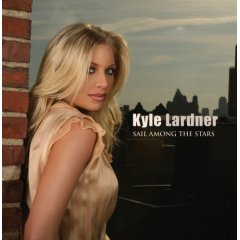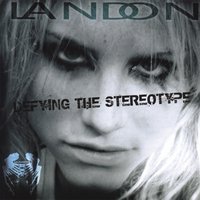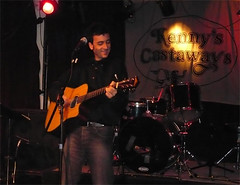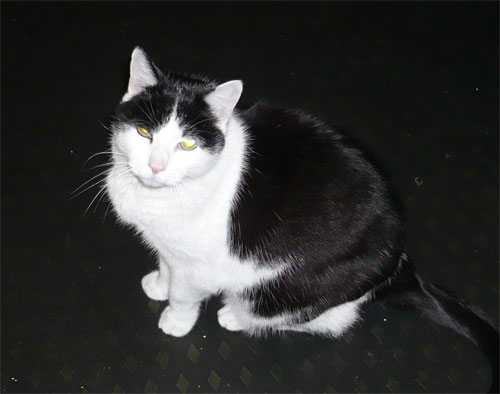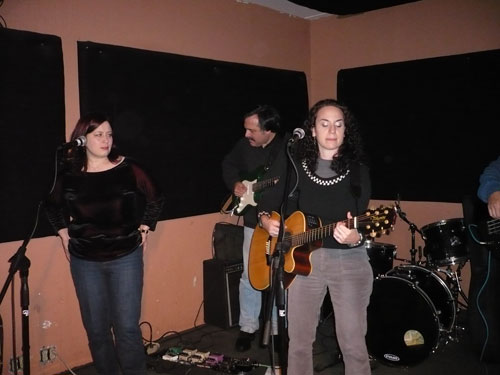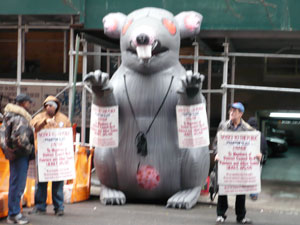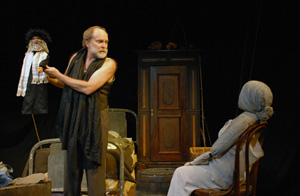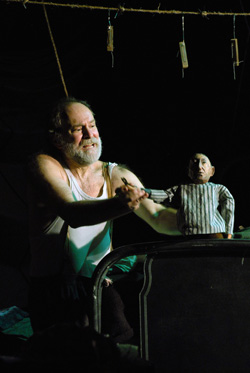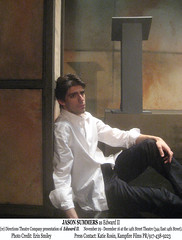Following the Northern Star is the second in Michael Gorman’s trilogy of plays about drug addiction in the New England fishing community. “A new Recovery model,” the playwright has explained, “emphasizes the return of the recovering addict to the community and the sharing of his or her story, as opposed to the anonymity model of Alcoholics Anonymous for instance.” (Emphasis mine.)
“Sharing of story” can mean two things, telling or showing. Telling, which may work brilliantly as therapy, isn’t generally what’s called for on the stage, where, not coincidentally, it’s called a “show.” The excellent opening scenes of this play indeed show much promise – but then, alas, the telling takes over.
The production takes full advantage of the large, versatile space of the La Mama Annex. The introductory scenes occur in a big pool of blue at some distance from the audience, and on a “bridge” far to the rear, but with the hall’s fine acoustics we have no trouble understanding the exposition. Three childhood friends play fishing-boat, but one, Robbie, is haunted by the specter of his alcoholic father. Then a couple of inland high school kids, Guy and Maria, banter winningly about their futures. Engineered by Gorman’s smart, hope-charged dialogue, these scenes brim with life.
Aided by haunting live music, the first act carries on into a present day in which the bookish Guy, shunning college, has followed his dream and begun to learn the trade of a commercial fisherman. The locals, including the charismatic but still troubled Robbie, live the stereotypically scrappy life of a hard-working, hard-drinking deep-sea fishing community. If Bruce Springsteen had grown up in a place like New Bedford he might have written characters like these. “Rich people,” Robbie says, “they can afford to fail. We have to succeed.”
But times are hard. While Robbie pursues his dreams of big catches, and recovers from the loss of more than one boat, his childhood friends Johnny and Therese both take jobs on land. Robbie, played with scabrous intensity by Michael Kimball, shares the spotlight with the set, most notably a wonderful, big rolling boat.
But the experimental goodies, which include cracks in the fourth wall and other conceptual elements, declamations, and dance, can’t rescue the thin plot. “I’m trying to make ends meet,” Therese says to her now-husband Robbie, “and you’re after the big score.” Throughout, adult Robbie’s psyche is revealed by explication, not action. The second act drags on and on; even the return of the delightful Maria (Ruth Coughlin) can’t save it. The sailor Ray (the excellent J. Paul Guimont), a heretofore minor character, launches into a gigantic monologue which, by the time it eventually goes somewhere, has thoroughly tried the viewer’s patience. The wretched extremes of emotion that flay Robbie, Johnny, Ray, and Therese as the plot unfolds feel unearned.
Maybe you need to have been to hell (and hopefully back), like the drug addicts who inspired the playwright, to get what’s going on here. But a play should create its own world, not demand familiarity with one that may be alien to most viewers. It’s fine to show us these miserable, drug-addicted men. But you have to make us care about them as people. The long speeches, drenched in moralizing and metaphors, left me impatient, wanting plot, dramatic interaction among the characters, something.
The staging is clever, interesting, and impressive. And, as evidenced by the first third of the play, Gorman can create vivid characters, and write snappy dialogue that walks the fine line between magic realism and real realism. In this play he has dragged men who’ve hit bottom onto the stage, kicking and screaming. But he hasn’t shown us how they got into such terrible trouble, or made us care about them.
Through Jan. 6 at La Mama.





